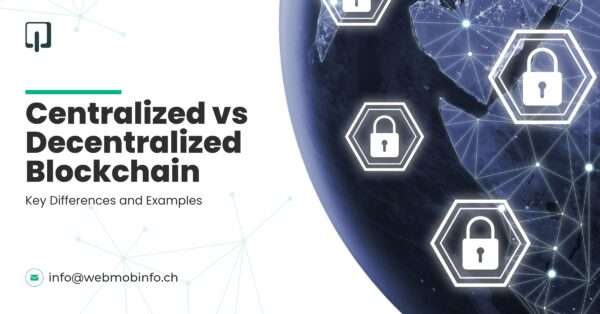Blockchain technology is transforming numerous industries by presenting approaches for carrying out transactions and managing data that are secure, transparent, and effective. Knowing the differences between these two models is important for businesses and developers that plan on adopting blockchain services. In this blog, we will delve into centralization and decentralization, examining their key characteristics and features to help you decide which is more suitable for use.
TABLE OF CONTENT
What is centralization?
It refers to a system where control and decision-making are centralized in a single entity or organization. In blockchain technology, a centralized blockchain operates under one central entity’s management. This central authority has the capability of approving the transactions, managing the network, and enforcing rules as well. Every node is dependent on the authority of the network to provide them with directions or to validate them.
Characteristics and Features of Centralized Blockchains
- Controlled Access: In the centralized blockchain, one authority has the right to access the network. This leads to high security and significant control over participation and actions within the system.
- Faster Transactions: Since the information on the transactions is verified and processed by a central authority, centralized blockchains can provide faster execution of transactions compared to decentralized ones.
- Simplified Governance: In centralized blockchains, the management process is smooth since the action is undertaken by one entity. This can result in faster adoption of the modifications and improvements.
- Scalability: Centralized blockchains are often more scalable since they do not require consensus with other nodes for each transaction. This makes them ideal for use in applications that require high levels of throughput.
What is decentralization?
Decentralization, on the other hand, is a structure where the authority and decision-making power are vested with several participants. In a decentralized blockchain, there is no central authority that has complete control as the network will be distributed. However, the network uses consensus, in which all participants (nodes) have equal validation of the transactions and the overall running of the network.
Characteristics and Features of Decentralized Blockchains
- Distributed Control: The hierarchy is complex, and no single organization or individual controls the network. However, all the nodes involved in the system share control, hence making the system less prone to manipulation.
- Enhanced Security: The decentralized structure makes these blockchains more secure. The security of the network is very high since an attacker would require control of many nodes to take over the network.
- Transparency and Trust: All the transactions are available to the public since they are recorded on the blockchain. This helps participants develop confidence as they can scrutinize the data themselves.
- Resilience: Decentralized blockchains are less prone to failure as compared to centralized ones. Thus, if some nodes are offline, the network will not be interrupted, as some of the nodes will still work.
Key Differences between centralized vs decentralized blockchains
The major difference between a centralized and decentralized blockchain is the level of control each has over its users. Let’s have a look at some of the major differences between centralized vs. decentralized blockchains:
| Centralized | Aspects | Decentralized |
| Single authority or organization. | Control | Held by multiple participants. |
| Fast, controlled by the central authority. | Decision-Making | Slower, requires consensus among nodes. |
| Faster due to the fewer nodes involved in verification. | Transaction Speed | Slower due to multiple nodes verifying transactions. |
| High, can handle more transactions per second (TPS). | Scalability | Lower, has issues with high TPS. |
| Lower, single point of failure . | Security | Higher, no single point of failure. |
| Depends on the central authority. | Transparency | High, all the transactions are recorded. |
| Simple, managed by a central entity. | Governance | Complex, requires consensus among participants |
| Less reliable as central authority can change the data. | Immutability | High, once the data is recorded it cannot be edited. |
| Higher fees due to intermediaries. | Exchange Fees | Lower fees, as no intermediaries are involved. |
Examples of Centralized Blockchains
Hyperledger Fabric: Hyperledger Fabric, a permissioned blockchain solution, is an enterprise ready blockchain solution developed by the Linux Foundation. It offers a centralized system where particular nodes of the system have authority over the network.
Ripple: Ripple is an international payment protocol that operates in real-time and is a gross settlement system with a centralized blockchain. Ripple is under the governance of Ripple Labs, hence providing fast transaction speeds and compliance with existing laws.
Examples of Decentralized Blockchains
Bitcoin: The original and most recognizable decentralized blockchain, Bitcoin, works on a decentralized P2P network with no governing body. Due to the lack of central authority, it is characterized by transparency and security.
Ethereum: Ethereum is a digital platform for the deployment of smart contracts and decentralized applications (dApps). It relies on a distributed network to verify transactions and maintain the blockchain.
Centralized vs Decentralized Blockchain: Which one is better?
Clearly, the choice in favor of a centralized or decentralized blockchain depends solely on the project’s requirements and objectives.
Centralized Blockchains: Suitable for use in applications that demand high TPS, scalability, and moderate levels of control. They are ideal for enterprise applications that require compliance with the law and the protection of information.
Decentralized Blockchains: Ideal for applications where the emphasis is on transparency, security, and the impossibility of censorship. These are ideal in use cases where trust and verification are paramount, as in the case of cryptocurrency and decentralized finance (DeFi).
Summing Up
Finally, it should be noted that the choice between centralized and decentralized blockchain is based on the specific needs of the business and the objectives to be achieved. Centralized blockchains have the advantages of speed, adjustability, and easy management, therefore making them suitable for organizations that need to process a significant number of transactions in a short time. On the other hand, decentralized blockchains offer better security, transparency, and immutability, which are highly beneficial for applications that require trust and accurate data.
This way, when the blockchain market changes, it is important to assess your needs and consider the prospects for decentralized development. Blockchain solutions are decentralized and can help your business establish the security and credibility that you require to gain your customers’ and partners’ trust.
Our team at Webmob Software is focused on creating customized decentralized blockchain solutions for your business. Whether you’re looking to boost security, increase transparency, or use all the possibilities of blockchain technologies, you can partner with our team of specialists. Get in touch with our experts to explore how decentralized development can take your business to the next level.
Frequently Asked Questions
What are the main differences between centralized and decentralized blockchains?
Centralized blockchains have a single governing entity and are fast and scalable, but they pose high risks to security and transparency. Decentralized blockchains have distributed control among the participants in the network, making them more secure and transparent, but the drawbacks are slow transaction rates and scalability.
Which type of blockchain is better for a business?
It depends on the business requirements that are involved in the company and the overall goals that need to be accomplished. Centralized blockchains are suitable for high throughput and fast decision-making, while decentralized blockchains are suitable for applications that require higher security and transparency.
How can a business implement decentralized blockchain solutions?
Decentralized blockchain solutions can be implemented by first determining the right application of blockchain, then choosing the right blockchain platform, and finally consulting with decentralized development experts.
Chahat has a deep passion for leveraging blockchain technology to drive innovation and transformation. With over seven years of experience, she has been instrumental in guiding WebMob through the complexities of blockchain adoption. Her expertise and forward-thinking approach make her a key thought leader in the blockchain space, paving the way for a modern decentralized industry.

